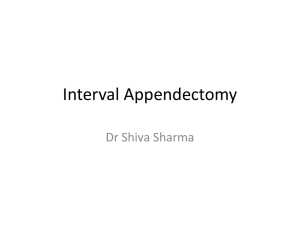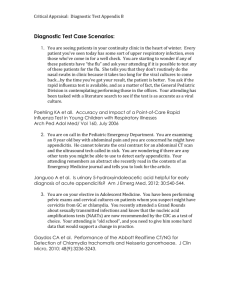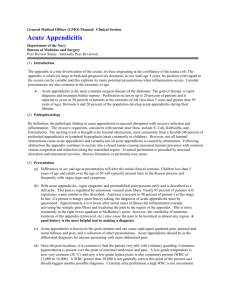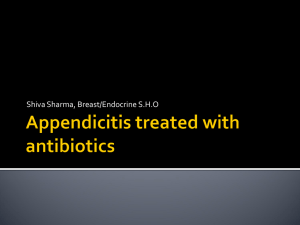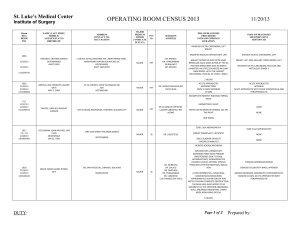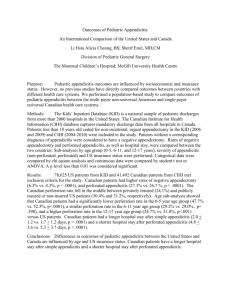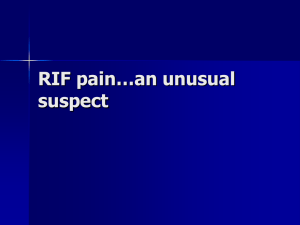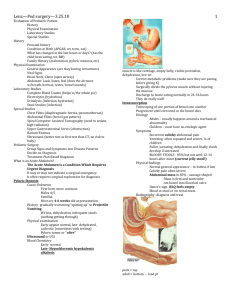Acute appendicitis - AUSL Città di Bologna
advertisement
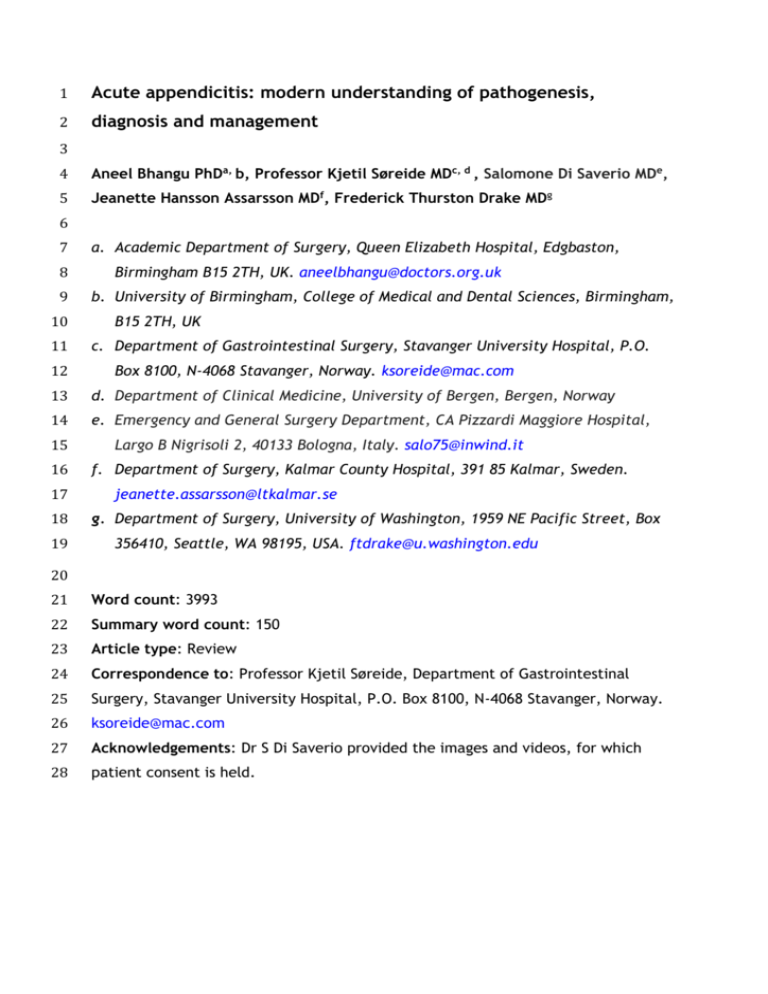
1 Acute appendicitis: modern understanding of pathogenesis, 2 diagnosis and management 3 4 Aneel Bhangu PhDa, b, Professor Kjetil Søreide MDc, d , Salomone Di Saverio MDe, 5 Jeanette Hansson Assarsson MDf, Frederick Thurston Drake MDg 6 7 8 9 10 11 12 a. Academic Department of Surgery, Queen Elizabeth Hospital, Edgbaston, Birmingham B15 2TH, UK. aneelbhangu@doctors.org.uk b. University of Birmingham, College of Medical and Dental Sciences, Birmingham, B15 2TH, UK c. Department of Gastrointestinal Surgery, Stavanger University Hospital, P.O. Box 8100, N-4068 Stavanger, Norway. ksoreide@mac.com 13 d. Department of Clinical Medicine, University of Bergen, Bergen, Norway 14 e. Emergency and General Surgery Department, CA Pizzardi Maggiore Hospital, 15 16 17 18 19 Largo B Nigrisoli 2, 40133 Bologna, Italy. salo75@inwind.it f. Department of Surgery, Kalmar County Hospital, 391 85 Kalmar, Sweden. jeanette.assarsson@ltkalmar.se g. Department of Surgery, University of Washington, 1959 NE Pacific Street, Box 356410, Seattle, WA 98195, USA. ftdrake@u.washington.edu 20 21 Word count: 3993 22 Summary word count: 150 23 Article type: Review 24 Correspondence to: Professor Kjetil Søreide, Department of Gastrointestinal 25 Surgery, Stavanger University Hospital, P.O. Box 8100, N-4068 Stavanger, Norway. 26 ksoreide@mac.com 27 Acknowledgements: Dr S Di Saverio provided the images and videos, for which 28 patient consent is held. 29 30 Summary 31 32 Acute appendicitis is one of the most common abdominal emergencies globally. 33 Etiology remains poorly understood with few advances over the past decades. 34 Obtaining a confident pre-operative diagnosis remains a challenge, as appendicitis 35 must be entertained in any patient presenting with an acute abdomen. While 36 biomarkers and imaging may be valuable adjuncts to clinical evaluation, none have 37 superior accuracy. A clinical classification is used to stratify management based on 38 simple (non-perforated) and complex (gangrenous or perforated) inflammation, 39 although many patients remain with an equivocal diagnosis, which remains one of 40 the most challenging dilemmas. An observed divide in disease course suggests some 41 simple appendicitis may be self-limiting or responding to antibiotics alone; another 42 appears to frequently perforate before reaching hospital. Although mortality is 43 low, post-operative complications are frequent in complex disease. We discuss 44 current knowledge in pathogenesis, modern diagnosis and evolving strategies in 45 management that are leading to stratified care for patients. 46 47 48 Introduction 49 50 Acute appendicitis is one of the most common general surgical emergencies 51 worldwide,1 with an estimated lifetime risk reported at 7-8 %._ENREF_2 52 Accordingly, appendectomy is one of the most commonly performed surgical 53 procedures and represents an important burden on modern health systems. Despite 54 being so common, limited understanding of etiology and absence of reliable 55 discriminators for disease severity still exist. Limited clinical research has produced 56 uncertainty about best practice with subsequent international variation in delivery 57 and, as a possible consequence, variation in outcome. The aim of this review is to 58 provide a state of the art update into the current controversies in pathogenesis, 59 diagnosis and clinical management of acute appendicitis. 60 61 62 63 64 Search strategy and selection criteria 65 66 We searched the Cochrane Library, MEDLINE, and EMBASE, limited to the final 67 search date (01/02/2015). We used the search terms “appendicitis” or “acute” in 68 combination with the terms “diagnosis” or “treatment”. We largely selected 69 publications in the past five years, but did not exclude commonly referenced and 70 highly regarded older publications. We also searched the reference lists of articles 71 identified by this search strategy and selected those we judged relevant. We 72 searched ClinicalTrials.gov (01/01/2000-01/02/2015) for current trials in acute 73 appendicitis. 74 75 76 Evolving understanding of acute appendicitis 77 78 Epidemiology 79 Acute appendicitis occurs at about 90-100 cases per 100,000 inhabitants per year in 80 the Western world. Peak incidence usually occurs in the 2nd or 3rd decade of life, 81 and the disease is less common at both extremes of age. Most studies show a slight 82 male predominance. Geographical differences are reported, with lifetime risks for 83 appendicitis of 16% in South Korea,_ENREF_3 9.0% in the USA_ENREF_4 and 1.8% in 84 Africa.2, 3_ENREF_2_ENREF_2 85 86 Etiology 87 Direct luminal obstruction may cause appendicitis (commonly by a faecolith, 88 lymphoid hyperplasia or impacted stool; rarely by an appendiceal or caecal 89 tumour) but may be exceptions rather than regular occurrences. While several 90 infectious agents are known to cause or be associated with appendicitis,4, 5 etiology 91 is still largely unknown. 6 Recent theories evolve around genetic factors, 92 environment and infections. 93 Although no defined gene has been identified, there is an almost three times 94 increased risk of appendicitis in members of families with a positive history for 95 appendicitis,7 and a twin study suggests genetic effects account for about 30% 96 variance in risk for developing appendicitis.8 97 Environmental factors may play a role, as studies note a predominate seasonal 98 presentation during the summer, which has been statistically associated with 99 higher level of ambient ground-level ozone, used as a marker of air pollution.9 100 Time-space clusters of disease presentation may further indicate an infectious 101 etiology._ENREF_6 Pregnant women appear to have a lower risk for appendicitis, 102 with lowest risk in third trimester, although being a diagnostic challenge when 103 present.10 104 Population level data on ethnicity from the UK and USA shows that appendicitis 105 is less common in non-white groups, albeit with little understanding of why. 11 106 Ethnic minority groups are conversely at higher risk of perforation, although this 107 might be due to unequal access to care rather than predisposition; definitive 108 evidence is lacking.12 109 Neurogenic appendicitis has also been suggested as a causative mechanism of 110 pain. Characterised by excess proliferation of nerve fibres into the appendix with 111 over-activation of neuropeptides, this poorly understood condition may be 112 relatively common, especially in children. From a case series of 29 patients, 113 neurogenicity was present in both inflamed and normal app_ENREF_11endix 114 specimens.13 It may theoretically provide an explanation for improvement after 115 normal appendectomy, although evidence for this and for its general importance is 116 limited. 117 118 The microbiome in appendicitis 119 The appendix may serve as a microbial reservoir for repopulating the 120 gastrointestinal tract in times of necessity, but data is limited. The bacterial 121 growth in removed inflamed appendices consists of a mix of aerobic and anaerobic 122 bacteria, most frequently dominated by E.coli and Bacteroides spp. A small yet 123 novel study using next-generation sequencing found a larger number and greater 124 variation of (up to 15) bacterial phylae than expected in patients with acute 125 appendicitis.14 Notably, the presence of Fusobacterium appeared to correspond to 126 disease severity (including risk of perforation), corroborating findings from archival 127 material in two other studies.15 128 Evidence of a role in immune balance comes from epidemiological studies 129 demonstrating a reduced risk of developing ulcerative colitis after appendectomy,16 130 with a slightly increased risk of Crohn’s disease.17 Further, appendectomy has been 131 associated with increased risk of future severe Clostridium difficile colitis requiring 132 colectomy.18 Whether these findings point to alterations of the human gut 133 microbiome or to the removal of a lymphoid organ with a role in human immune 134 function is currently unknown._ENREF_31 135 136 Classification 137 Irrespective of etiology, clinical stratification of severity at presentation, which 138 relies on pre-operative assessment rather than post-operative histopathology, is 139 advantageous for surgeons and patients as it allows stratified peri-operative 140 planning. However many patients can only be classified with an equivocal 141 diagnosis, which remains one of the most challenging dilemmas in the management 142 of acute abdominal pain. The pathological basis of each strata are shown in table 1 143 and figure 1. 144 A debated theory divides acute appendicitis into separate forms of acute 145 inflammation processes with different fates. One is the simple inflamed 146 appendicitis without gangrene or necrosis that does not proceed to perforation. 147 This “reversible” form may present as phlegmonous (pus-producing), or advanced 148 inflammation (but without gangrene or perforation) that may require surgery, or 149 alternatively a mild inflammation who may settle spontaneously or with antibiotic 150 therapy. In contrast, the more severe inflammatory type rapidly proceeds to 151 gangrene and/or perforation. Data to support separate types of inflammation arises 152 from clinical registries19 and laboratory studies.20 In population-based studies, the 153 rate of non-perforated appendicitis declined in males, with even greater declines 154 in females.21 However a similar decline in rate of perforated appendicitis was not 155 seen. Although this points to disconnect between perforated and non-perforated 156 disease, it may also represent improved diagnosis with increased used of imaging 157 over the period, reclassifying some previous labelled early appendicitis into other 158 diagnoses. 159 160 161 Modern diagnostic strategies 162 Modern diagnosis aim to firstly confirm or eliminate a diagnosis of appendicitis, and 163 secondly to stratify simple and complex disease when appendicitis is suspected. 164 The optimum strategy that limits harm (e.g. radiation from imaging) whilst 165 maintaining a high degree of accuracy has still not achieved consensus, 166 representing the difficulty faced by patients and surgeons. 167 168 Biomarkers 169 Biomarkers are used to supplement history and clinical exam, especially in 170 children, women of fertile age and the elderly where diagnosis is difficult. No 171 inflammatory marker alone, including white blood cell (WBC) count, c-reactive 172 protein (CRP) or other novel tests including procalcitonin, can identify appendicitis 173 with high specificity and sensitivity.22_ENREF_24_ENREF_25 However, WBC count is 174 obtained in virtually all patients being assessed for appendicitis, where available. A 175 range of novel biomarkers has been suggested over the last decade, including 176 bilirubin_ENREF_28, but these lack external validity and repeatedly suffer from low 177 sensitivity, meaning they are unlikely to come into clinical practice. 23 178 179 Clinical decision rules/risk scores 180 Each and every clinical sign for appendicitis alone has a poor predictive value. 181 However, in combination the predictive ability is much stronger, although not with 182 perfect accuracy. Consequently, a number of clinical risk scores have been 183 developed, the purpose of the clinical scores are to identify low, intermediate or 184 high-risk patients for appendicitis (figure 2), allowing further investigations to be 185 stratified according to risk (figure 3).24 186 The most widely used to date is the Alvarado score. _ENREF_26A systematic 187 review and pooled diagnostic accuracy study showed that the score has good 188 sensitivity (especially in men) but low specificity, limiting its clinical impact and 189 meaning few surgeons rely on it to guide management above and beyond their own 190 clinical opinion. The predictive ability of each component of the recently derived 191 modified Alvarado score in children is shown in supplemental table 1. 25 Recently 192 the appendicitis inflammatory response score has been developed, and appears to 193 outperform the Alvarado score in accuracy.26 194 195 Transabdominal ultrasonography 196 Initial reliance on ultrasound has been more recently guarded due to moderate 197 sensitivity (86%, 95% confidence interval 0.83-0.88) and specificity (81%, 78%-84%%) 198 shown through pooled diagnostic accuracy of 14 studies27,_ENREF_35 limiting its 199 diagnostic ability. Due to the need for a specialist operator, it is frequently 200 unavailable out of hours and at weekends, further limiting its usefulness. Its first 201 line investigative role is greater in paediatric populations, who typically have 202 thinner musculature, less abdominal fat than adults and a greater need for 203 radiation avoidance_ENREF_68. 204 205 Computed tomography 206 In adolescent and adult patients, computed tomography has become the most 207 accepted imaging strategy. In the USA, it is used in 86% of patients, with a 208 sensitivity of 92.3%.28 This has led to a normal appendectomy rate of 6%. Uptake 209 outside of North America is lower due to concerns over risk of radiation exposure in 210 children and young adults, differing hospitals remuneration systems, unavailability 211 outside of normal hours and absence of scanners in low resource hospitals. 212 In one RCT comapring low-dose versus standard-dose CT in 891 patients, the 213 normal appendectomy rate was 3.5% versus 3.1% respectively, although these 214 advanced technology scanners are not in widescale use. 29 For older patients at 215 higher risk of malignancy, pre-operative CT is recommended to identify malignancy 216 masquerading as (or, causing) appendicitis. Selective CT based on clinical risk 217 scores is likely to target its use and justify radiation exposure (figure 3)._ENREF_36 218 219 Magnetic resonance imaging (MRI) 220 MRI for patients with an acute abdomen may eliminate the risks associated with 221 radiation use in young patients._ENREF_31 However, little is know about the exact 222 utility and accuracy in acute abdomen. For one, there are few units worldwide able 223 to provide immediate access MRI at present. Second, MRI currently has no better 224 accuracy than ultrasound in discriminating perforated appendicitis. 30 225 226 Diagnostic strategies in young female patients 227 In fertile female patients, the initial approach includes urinary pregnancy test to 228 identify possible ectopic pregnancy and transvaginal ultrasound to identify ovarian 229 pathology. In equivocal cases, a thorough clinical assessment (including pelvic 230 examination) by on-call gynaecologists can differentiate alternative pathology and 231 direct further investigations. Early laparoscopy has been suggested as a method to 232 improve diagnosis in female patients with an equivocal diagnosis, having so far 233 been assessed in single centre randomised trials. When compared to clinical 234 observation and selective escalation, routine early laparoscopy increases the rate 235 of diagnosis and may facilitate earlier discharge.31, 32 236 237 Differentiating simple from complex disease 238 At present, both CT and emergency MRI lack ability to discriminate between non- 239 perforated and perforated appendicitis30._ENREF_31 This limits clinicians’ ability to 240 objectively stratify patients for short in-hospital delays prior to surgery or for 241 selection to trials of non-operative treatment with antibiotics. Presence of an 242 appendicolith in radiological imaging is associated with both a higher risk of 243 antibiotic failure and recurrence,33 whereas the triad of CRP <60g/L, WCC<12x109 244 and age <60 years has been reported to predict antibiotic success. 34 245 246 Treatment strategies 247 248 Non-operative management 249 Primary antibiotic treatment of simple inflamed appendicitis 250 Antibiotics have more recently been proposed as single treatment for 251 uncomplicated appendicitis, but not without controversy. Meta-analysis of RCTs 252 c_ENREF_41omparing antibiotics with appendectomy has shown that although 253 antibiotic treatment alone can be successful, _ENREF_45_ENREF_45patients should 254 be made aware of a failure rate at one year of around 25-30% with need for 255 readmission or surgery (table 2).35 Pilot RCT suggests this strategy may also be 256 effective in children36, although similarly to adults, 38% require subsequent 257 appendectomy during follow-up. 258 The RCTs have methodological limitations including different criteria for 259 diagnosis, low inclusion rate, inadequate outcome measures and different follow- 260 up between groups.37-40 Importantly, some studies did not confirm diagnosis with 261 imaging, which in combination with substantial crossover between study arms, has 262 led some surgeons to question the validity. Within the most recent meta-analysis, 263 three studies originated from Sweden_ENREF_41 and one from France,_ENREF_44 264 meaning that these findings may not be automatically generalizable worldwide due 265 to potential ethnicity and health care access issues. 266 Until more accurate selection criteria emerge (based on combinations of 267 clinical risk scores and imaging) for patients or subgroups who are likely to succeed 268 in the long term from primary antibiotic treatment, suitable patients with mild 269 symptoms (representing mild to moderate appendicitis) should ideally be entered 270 into randomised clinical trials, or at minimum be counselled about a 25-30% one 271 year failure rate. 272 273 Choice of antibiotic regimen 274 Antibiotics with aerobic and anaerobic coverage for ordinary bowel bacteria should 275 be given, taking into account local resistance patterns and the potential for 276 heterogeneous etiology. Antibiotics have been given intravenously for one to three 277 days in all the referred trials; total oral therapy has not been tested. Therefore, it 278 is reasonable to recommend at least one day of intravenous treatment and also 279 hospital surveillance considering that rescue appendectomy has been judged 280 necessary for 5-23% of patients (table 2). Oral antibiotics have subsequently been 281 given for 7-10 days as part of this regimen, illustrating the potential for slower 282 recovery in some patients, albeit whilst avoiding early surgery. The length and 283 nature of treatment should be subject for future research. 284 285 _ENREF_47_ENREF_40Spontaneous resolution 286 Periods of active observation resulting in resolution suggest that spontaneous 287 resolution of simple appendicitis is possible. RCTs comparing active observation 288 with antibiotic treatment have not been made and therefore it is impossible to 289 know whether the reported recovery rates (77-95%; table 2) after primary 290 antibiotics represents a true treatment effect or just the natural course of simple, 291 acute appendicitis. Safe selection criteria for active observation alone to treat 292 confirmed appendicitis do not exist and so it is not recommended as a current 293 treatment strategy outside trials. 294 295 Appendiceal abscess 296 Pre-surgery intra-abdominal or pelvic abscess is found in 3.8% (95% CI 2.6-4.9) of 297 patients presenting with appendicitis and should be suspected in those presenting 298 with a palpable mass. Whilst pre-hospital delay was considered a traditional risk 299 factor, evidence of disconnect between the strata of disease severity means that 300 some patients may be at risk of abscess formation despite prompt treatment. 21 301 Meta-analyses on mainly retrospective studies recommend conservative treatment 302 consisting of antibiotics with percutaneous drainage of abscess if needed. 303 Immediate surgery is associated with higher morbidity (pooled odds ratio 3.3, 95% 304 CI 1.9-5.6) and risk of unnecessary ileoceacal resection; the recurrence rate is 7.4% 305 (95% CI 3.7-11.1).41 306 307 Follow-up after non-operative management 308 Following conservatively treated abscess, 1.2% of patients will be found to have 309 malignancy.41 Follow-up with colonoscopy and/or CT after conservatively treated 310 appendiceal abscess is recommended in patients aged ≥40 years, or those with 311 symptoms or laboratory/radiologic signs that are suspicious of colonic malignancy. 312 The rate of occult appendiceal malignancy after initial successful antibiotic 313 treatment for simple (non-perforated) appendicitis is unknown. Long-term (beyond 314 one year) evidence of outcome and optimum follow-up of is lacking; only one study 315 reports a recurrence rate of 14% after two years.42 Extrapolating from abscess, 316 patients ≥40 or those with other suspicious symptoms should be considered for 317 further investigation to identify malignancy, which may include interval 318 appendectomy in selected cases based on age, on-going symptoms and/or 319 radiological findings. 320 _ENREF_23 321 Operative treatment 322 Timing of surgery 323 Outcomes in relation to timing of surgery have been controversial, especially since 324 disease presentation may vary with time of day. Meta-analysis of 11 non- 325 randomised studies (8858 patients) showed that short in-hospital delays of 12-24 326 hours in selected, stable patients were not associated with increased risk of 327 perforation (odds ratio 0.97, 95% CI 0.78-1.19, p=0.750).43 Notably, allowing a 328 delay or, rather, an increased observation time in patients with equivocal signs, 329 with renewed interval clinical assessment increases diagnostic accuracy without 330 increased risk of perforation in acute appendicitis. Delays can aid service provision, 331 avoiding night-time operating and increasing access to daytime technological 332 resources where available.44 333 Emergency surgery models can structurally separate elective from 334 emergency care, reduce night-time surgery and improve emergency theatre 335 efficiency.45 Planned early laparoscopy in patients with an equivocal diagnosis can 336 improve the diagnostic rate and facilitate early discharge (without increasing the 337 risk of complications).31, 32 Ambulatory appendectomy, leading to day of surgery 338 discharge, has been reported from single centres and is potentially attractive to 339 improve patient satisfaction and reduce costs in patients with simple 340 inflammation.46 341 342 Surgical approach 343 _ENREF_53Use of laparoscopic appendectomy depends on availability and 344 expertise, with equivalent results achievable from urban centres in India and Africa 345 compared to the UK and USA47. The concept of low-cost laparoscopy, using simple, 346 inexpensive, reusable devices can lead to equivalent costs and outcomes even in 347 complex appendicitis.48 348 349 Role of laparoscopic appendectomy in specific populations 350 Laparoscopy is safely performed in children and the obese with favourable 351 outcomes and low risk profile. 352 and access to specialist equipment and so does not need to be mandated. 353 Appendicitis in pregnancy remains challenging due to displacement of the caecum 354 by the growing uterus. Meta-analysis of low-grade observational evidence suggests 355 that laparoscopic appendectomy in this group is associated with a higher rate of 356 foetal loss compared to an open approach (3415 women, 127 events, relative risk 357 1.91, 95% CI 1.31-2.77).51 However, selection bias and confounders might have 358 influenced these observational results; open appendectomy remains as standard. A 359 selection of best available evidence for surgeons guiding intra-operative decision- 360 making is shown in supplemental table 2. 49 50 Its availability and use depends on expertise 361 362 Novel surgical technologies 363 Single incision laparoscopic surgery (SILS) and low-cost SILS techniques (e.g. 364 “surgical glove port”, supplemental videos 1 and 2) have been recently described 365 and may be performed with inexpensive equipment and routine instruments, 366 leading to satisfactory functional and cosmetic results52. Meta-analysis of 7 RCTs 367 comparing SILS to conventional laparoscopy demonstrate no real differences for 368 SILS, and considerable heterogeneity exist between studies. 53 369 Natural orifice transluminal endoscopic surgery (NOTES) is a technological 370 adaptation of laparoscopy that is available in well-funded centres. Its role and 371 application (transvaginal approach in women; transgastric approach in both 372 genders) is controversial and debated.54 373 Since the role of these technologies seems to be in providing marginal gains 374 to selected patients (which may only be neutral or at best improved cosmetic 375 outcome at the cost of longer operative times and higher post-operative pain53, 55), 376 widespread adoption seems unlikely in light of raised cost and increased procedural 377 complexity. 378 379 Administration of pre-operative and duration of post-operative antibiotics 380 Pre-operative prophylactic antibiotics should be started well before skin incision 381 commences (>60 minutes) and may be initiated as soon as the patient is scheduled 382 for surgery. Broad coverage of gram-negatives is warranted based on studies on 383 microbiology cultures. Metronidazole given intravenously is usually well tolerated, 384 and given alone or in combinations in most studies.56 Piperacillin/tazobactam is 385 also adequate, in particular if perforation or complex disease is suspected on pre- 386 operative diagnosis. Meta-analysis of randomised trials comparing prophylactic pre- 387 operative antibiotics to placebo showed significant reduction of wound infection 388 with either single agent (11 studies, 2191 patients, OR 0.34, 95% CI 0.25-0.45) or 389 multiple agents (2 studies, 215 patients, OR 0.14, 95% CI 0.05-0.39).57 390 _ENREF_57_ENREF_61 391 Administration of post-operative antibiotics is stratified by disease severity. 392 Routine post-operative antibiotics following surgery for simple inflamed 393 appendicitis are not recommended.58 Currently, 3-5 days of post-operative 394 intravenous antibiotics are recommended for complex, perforated appendicitis. 395 Adjusted observational data suggests that three days post-operative antibiotic 396 duration is as effective as 5 days.59 Shorter duration of antibiotics based on 397 cessation following resolution of bedside clinical parameters (core temperature < 398 38 degrees C for 24 hours, tolerated two consecutive meals, mobilizing 399 independently, requiring only oral analgesia) may be equally as efficacious, as 400 proven in paediatric populations.60 Patients should be informed about a continued 401 risk of post-operative abscess formation in perforated appendicitis. 402 403 404 Outcomes 405 Histopathological assessment and risk of neoplasm 406 Routine histopathological assessment of all appendectomy specimens has been 407 debated (as a means to save costs), but remains as a best practice 408 recommendation, primarily due to the ability to identify malignancy in 1%. This is 409 most often in the form of a neuroendocrine tumour of the appendix (so-called 410 carcinoid), an adenocarcinoma or mucinous cystadenoma.61 Specific definitions of 411 appendiceal inflammation lack consensus agreement through a lack of multicentre 412 research, thus meaning some patients labelled with a normal appendix and 413 subsequently being subject to further investigation may in fact have had subtle 414 inflammation.62 415 416 Mortality 417 Although the most severe of all adverse events, mortality in developed health 418 systems is low (between 0.09%63 and 0.24%64) and lacks sensitivity to detect 419 differences in care processes which lead to variation in other outcomes. In LMIC 420 countries, mortality is reported as 1-4%, and so it may represent a useful marker 421 for worldwide care.65, 66 422 423 Perforation rate 424 Low perforation rates were previously used as a marker of better performing units 425 with more prompt access to surgical intervention. However, patients presenting 426 from rural versus urban locations in both developed and developing nations have 427 longer duration of symptoms with higher rates of perforation, although this could 428 also be the result of ethnic predisposition to perforation.67 Additionally, since 429 perforation may result from a separate clinical process than the one at work in 430 non-perforated disease21, it is increasingly recognised that, as a marker of hospital 431 quality, it is a poor measure. 432 433 Normal appendectomy rate 434 In countries with rapid access to CT and diagnostic laparoscopy, the normal 435 appendectomy rate has fallen over the last decade. Rates vary from 6% in the USA 436 (high use of pre-operative CT),28 6.1% in Switzerland (routine use of laparoscopy),68 437 20.6% in the UK (selective use of CT and laparoscopy),69 with variable rates from 9% 438 to 27.3% across India, China, Sub-Saharan Africa, North Africa and the Middle 439 East.61, 65 This rate is also dependent on inter-observer variability of 440 histopathological examination and definitions used. 62 Although normal 441 appendectomy rate can act as a marker of individual hospital pathways, it is one- 442 dimensional in approach, since it does not take into account patients treated non- 443 operatively and is thus a relatively poor universal marker of quality. 444 445 Short-term morbidity 446 Post-operative adverse event profiles vary depending on disease severity, the 447 specific complication, method of detection and the geographical location. Overall 448 complication rates of 8.2%-31.4%, wound infection rates of 3.3%-10.3% and pelvic 449 abscess rates up to 9.4% have been reported.69, 70 450 451 Long-term morbidity 452 Population level data comparing laparoscopic and open surgery shows small long- 453 term outcome differences of little clinical relevance.71 This data also showed that 454 negative appendectomy was associated with higher mortality at 30 days and five 455 years compared to perforated appendicitis.72 Although this could be due to 456 association with underlying undetected morbidity, it could also reflect morbidity of 457 surgical exploration, potentially justifying greater use of pre-operative cross- 458 sectional imaging. Trials with outcome measures related to medium and long-term 459 patient reported satisfaction are severely lacking. 460 461 462 Future research directions 463 A range of research for each step of the patient pathway is required to modernise 464 and standardise the treatment of acute appendicitis internationally; on-going 465 research is shown in supplemental table 3. Research relevant to both low-middle 466 income and high-income countries should be promoted. Both randomised and non- 467 randomised research can promote equality of access to care and reduce variation 468 in outcome. Correct application of technology, for both diagnosis and treatment, 469 needs to be rationalised, justified and optimised through formalised research 470 programmes. Population level data currently being collected should be used to 471 better define variation, plan relevant research questions and develop networks for 472 delivery of trials. 473 474 475 Panel: Key messages 476 477 An accurate pre-operative diagnosis of acute appendicitis is challenging, as 478 the diagnosis must be entertained in patients of all ages presenting with an 479 acute abdomen. 480 481 Worldwide variation in care is indicated by variance in use of computed tomography, administration of antibiotics and removal of a normal appendix. 482 A clinical classification system based on simple (non-perforated) and 483 complex (gangrenous or perforated) inflammation allows a stratified 484 approach to management. This stratification includes timing of surgery, 485 trials of non-operative management and use of post-operative antibiotics. 486 Independent of diagnostic and management approach, the perforation rate 487 has remained stable. The non-perforated appendicitis rate has changed, 488 suggesting possible independent disease processes. 489 Increased use of pre-operative computed tomography results in lower normal 490 appendectomy rates, at the cost of higher radiation exposure for patients. 491 Some simple appendicitis may be treated with antibiotics alone, although 492 more accurate selection criteria to support this approach are required. At 493 present, patients should be counselled about a high rate of failure (25-30%) 494 at one year. 495 496 497 Appendectomy is related to inflammatory bowel disease, pointing to immunological mechanisms and potential role of the gut microbiome. Laparoscopy is the surgical approach of choice where local resources allow, 498 with slightly improved short-term outcomes (including less post-operative 499 pain and shorter length of stay) but no difference in long-term outcomes 500 compared to open surgery. 501 502 503 Conflict of interest statement 504 AB – no conflicts of interest 505 KS – no conflicts of interest 506 SDS – no conflicts of interest 507 JA – no conflicts of interest 508 FTD – no conflicts of interest 509 510 Contribution by authors: AB and KS planned the review. Each author drafted a 511 topic section outline. AB collated the sections and drafted the first version. AB, KS, 512 SDS, JA, FTD performed rounds of revisions, edited the draft and approved the 513 final manuscript. 514 515 516 517 Table 1: Stratified disease approach to acute appendicitis. Disease state Normal (figure 1A) Underlying pathology Normal Macroscopic appearances No visible changes Acute intraluminal inflammation No visible changes Acute mucosal/ submucosal inflammation No visible changes Simple, nonperforated (figure 1B) Suppurative/ phlegmonous Congestion, colour changes, increased diameter, exudate, pus. Complex (figure 1C) Gangrenous Friable appendix with purple, green or black colour changes Perforated Visible perforation Abscess (pelvic/ abdominal) Mass found during examination or abscess seen on pre-op imaging; abscess or found at surgery Microscopic appearances Absence of any abnormality Luminal neutrophils only with no mucosal abnormality Mucosal/ submucosal neutrophils and/or ulceration Transmural inflammation/ ulceration/ thrombosis, +/extramural pus Transmural inflammation with necrosis Clinical relevance Perforation; not always visible in microscope Transmural inflammation with pus +/- perforation Higher risk of post-operative complications Higher risk of post-operative complications Consider other causes May be cause of symptoms; consider other causes. May be cause of symptoms; consider other causes Likely cause of symptoms Impending perforation 518 519 520 521 Legend: modified from the classification system by Carr6. Photographic examples of macroscopic pathology are shown in figure 1. 522 523 Table 2: Clinical trials comparing primary antibiotic treatment vs. surgery for acute 524 appendicitis. 525 Study design Patients (n) Antibiotic treated patients (n) Age (years)/ gender Diagnosis Antibiotic regimen (days) Recovery rate (%) 1-year failure (%) 1-year efficacy** (%) RCT 40 20 ≥18 US iv 2 oral 8 95 37 60 Styrud 200638 RCT multicentre 252 128 18-50 male clinical iv 2 oral 10 88 14 76 Hansson 200939 RCT multicentre 369 119 ≥18 clinical (+US/CT)* iv 1 oral 9 91 14 78 Vons 201140 Svensson 201436 RCT multicentre 239 120 ≥18 CT 88 25 68 RCT 50 24 5-15 US (+CT)* 92 5 62 Turhan 200973 Prospective interventional 290 107 ≥16 US or CT iv 3 oral 7 82 10 74 Hansson 201274 Prospective interventional 558 442 ≥16 clinical (+US/CT)* iv 1 oral 9 77 11 69 Di Saverio 201442 Prospective 159 interventional RCT multicentre (Estimated 600 completion 2025) 159 ≥14 clinical (+US/CT)* total 5-7 88 13 77 - - - - - - - Eriksson 199537 APPAC study (on-going; NCT01022567) 526 527 528 529 530 531 CT = computer tomography US = ultrasound Iv = intravenous * if judged clinically necessary ** overall efficacy at one year including recurrence iv 2 oral 8 Iv 2 oral 8 532 533 Figure 1: Panel title: Macroscopic pathological features of appendicitis 534 535 Figure 1A: Macroscopically normal appendix. 536 537 Figure 1B: Simple inflamed appendicitis. 538 539 540 Figure 1C: Complex appendicitis showing perforation with pus formation. 541 542 543 Figure 2: Clinical risk scoring for suspected acute appendicitis 544 545 Figure 3: Flowchart illustrating guidance for a stratified approach to pre-operative 546 management of suspected appendicitis Presentation Guidance for a stratified approach to pre-operative management of suspected appendicitis Acute right iliac fossa pain >History and examination, urine dipstick (including pregnancy test), blood tests Clinical risk score Imaging Initial clinical impression Low risk Intermediate risk Consider ultrasound Consider CT Normal appendix High risk Consider CT confirmation (dependent on local practice) Equivocal Clinically appendicitis Simple >non-perforated Mild clinical signs Initial management Failure of initial management Non-operative >Discharge Non-operative >Active observation Further investigations >consider CT Operative: Diagnostic laparoscopy 547 548 Trial non-operative: >Primary antibiotic therapy Operative: >appendicectomy Complex >likely or impending perforation Advanced >unlikely to settle without surgery Operative: >appendicectomy Established abscess >mass, may be painless >extended history Non-operative: >Antibiotics >Radiological drainage Operative: >Surgical drainage 549 550 551 552 References 1. 553 554 requiring emergency surgery. Brit J Surg 2014;101(1):e9-22. 2. 555 556 3. Ohene-Yeboah M, Abantanga FA. Incidence of acute appendicitis in Kumasi, Ghana. West Afr J Med. 2009; 28(2): 122-5. 4. 559 560 Lee JH, Park YS, Choi JS. The epidemiology of appendicitis and appendectomy in South Korea: national registry data. J Epidemiol. 2010; 20(2): 97-105. 557 558 Stewart B, Khanduri P, McCord C, et al. Global disease burden of conditions Lamps LW. Infectious causes of appendicitis. Infect Dis Clin North Am 2010;24(4):995-1018. 5. Dzabic M, Bostrom L, Rahbar A. High prevalence of an active cytomegalovirus 561 infection in the appendix of immunocompetent patients with acute appendicitis. 562 Inflamm Bowel Dis 2008;14(2):236-41. 563 6. Carr NJ. The pathology of acute appendicitis. Ann Diagn Pathol 2000;4(1):46-58. 564 7. Ergul E. Heredity and familial tendency of acute appendicitis. Scand J Surg 565 566 2007;96(4):290-2. 8. 567 568 Sadr Azodi O, Andren-Sandberg A, Larsson H. Genetic and environmental influences on the risk of acute appendicitis in twins. Brit J Surg 2009;96(11):1336-40. 9. Wei PL, Chen CS, Keller JJ, Lin HC. Monthly variation in acute appendicitis 569 incidence: a 10-year nationwide population-based study. J Surg Res 570 2012;178(2):670-6. 571 10. Zingone F, Sultan AA, Humes DJ, West J. Risk of Acute Appendicitis in and Around 572 Pregnancy: A Population-based Cohort Study From England. Ann Surg. 2015; 573 261(2): 332-7. 574 11. Anderson JE, Bickler SW, Chang DC, Talamini MA. Examining a common disease 575 with unknown etiology: trends in epidemiology and surgical management of 576 appendicitis in California, 1995-2009. World J Surg. 2012; 36(12): 2787-94. 577 12. Lee SL, Shekherdimian S, Chiu VY. Effect of race and socioeconomic status in the 578 treatment of appendicitis in patients with equal health care access. Arch Surg. 2011; 579 146(2): 156-61. 580 13. Sesia SB, Mayr J, Bruder E, Haecker FM. Neurogenic appendicopathy: clinical, 581 macroscopic, and histopathological presentation in pediatric patients. Eur J Pediatr 582 Surg. 2013; 23(3): 238-42. 583 14. Guinane CM, Tadrous A, Fouhy F, Ryan CA, Dempsey EM, Murphy B, et al. 584 Microbial composition of human appendices from patients following appendectomy. 585 mBio. 2013; 4(1). 586 15. Swidsinski A, Dorffel Y, Loening-Baucke V, et al. Acute appendicitis is characterised 587 by local invasion with Fusobacterium nucleatum/necrophorum. Gut. 2011; 60(1): 34- 588 40. 589 16. Frisch M, Pedersen BV, Andersson RE. Appendicitis, mesenteric lymphadenitis, and 590 subsequent risk of ulcerative colitis: cohort studies in Sweden and Denmark. Brit Med 591 J 2009;338:b716. 592 17. Kaplan GG, Pedersen BV, Andersson RE, Sands BE, Korzenik J, Frisch M. The risk 593 of developing Crohn's disease after an appendectomy: a population-based cohort 594 study in Sweden and Denmark. Gut. 2007; 56(10): 1387-92. 595 18. Clanton J, Subichin M, Drolshagen K, Daley T, Firstenberg MS. Fulminant 596 Clostridium difficile infection: An association with prior appendectomy? World J 597 Gastrointest Surg. 2013; 5(8): 233-8. 598 19. Andersson RE. The natural history and traditional management of appendicitis 599 revisited: spontaneous resolution and predominance of prehospital perforations imply 600 that a correct diagnosis is more important than an early diagnosis. World J Surg. 601 2007; 31(1): 86-92. 602 20. Ruber M, Andersson M, Petersson BF, Olaison G, Andersson RE, Ekerfelt C. 603 Systemic Th17-like cytokine pattern in gangrenous appendicitis but not in 604 phlegmonous appendicitis. Surgery. 2010; 147(3): 366-72. 605 21. Livingston EH, Woodward WA, Sarosi GA, Haley RW. Disconnect between incidence 606 of nonperforated and perforated appendicitis: implications for pathophysiology and 607 management. Ann Surg. 2007; 245(6): 886-92. 608 22. Yu CW, Juan LI, Wu MH, Shen CJ, Wu JY, Lee CC. Systematic review and meta- 609 analysis of the diagnostic accuracy of procalcitonin, C-reactive protein and white 610 blood cell count for suspected acute appendicitis. Br J Surg. 2013; 100(3): 322-9. 611 23. Andersson M, Ruber M, Ekerfelt C, Hallgren HB, Olaison G, Andersson RE. Can New 612 Inflammatory Markers Improve the Diagnosis of Acute Appendicitis? World J Surg. 613 2014. 614 24. Leeuwenburgh MM, Stockmann HB, Bouma WH, et al. A simple clinical decision rule 615 to rule out appendicitis in patients with nondiagnostic ultrasound results. Acad Emerg 616 Med. 2014; 21(5): 488-96. 617 25. 618 619 Ohle R, O'Reilly F, O'Brien KK, Fahey T, Dimitrov BD. The Alvarado score for predicting acute appendicitis: a systematic review. BMC Med. 2011; 9: 139. 26. Kollar D, McCartan DP, Bourke M, Cross KS, Dowdall J. Predicting acute 620 appendicitis? A comparison of the Alvarado score, the appendicitis inflammatory 621 response score and clinical assessment. World J Surg. 2015; 39(1): 104-9. 622 27. Terasawa T, Blackmore CC, Bent S, Kohlwes RJ. Systematic review: computed 623 tomography and ultrasonography to detect acute appendicitis in adults and 624 adolescents. Ann Intern Med. 2004; 141(7): 537-46. 625 28. Cuschieri J, Florence M, Flum DR, Jurkovich GJ, Lin P, Steele SR, et al. Negative 626 appendectomy and imaging accuracy in the Washington State Surgical Care and 627 Outcomes Assessment Program. Ann Surg. 2008; 248(4): 557-63. 628 29. 629 630 Kim K, Kim YH, Kim SY, et al. Low-dose abdominal CT for evaluating suspected appendicitis. N Engl J Med. 2012; 366(17): 1596-605. 30. Leeuwenburgh MM, Wiezer MJ, Wiarda BM, et al. Accuracy of MRI compared with 631 ultrasound imaging and selective use of CT to discriminate simple from perforated 632 appendicitis. Br J Surg. 2014; 101(1): e147-55. 633 31. Decadt B, Sussman L, Lewis MP, et al. Randomized clinical trial of early laparoscopy 634 in the management of acute non-specific abdominal pain. Br J Surg. 1999; 86(11): 635 1383-6. 636 32. Morino M, Pellegrino L, Castagna E, Farinella E, Mao P. Acute nonspecific abdominal 637 pain: A randomized, controlled trial comparing early laparoscopy versus clinical 638 observation. Ann Surg. 2006; 244(6): 881-6. 639 33. Shindoh J, Niwa H, Kawai K, et al. Predictive factors for negative outcomes in initial 640 non-operative management of suspected appendicitis. J Gastrointest Surg. 2010; 641 14(2): 309-14. 642 34. Hansson J, Khorram-Manesh A, Alwindawe A, Lundholm K. A model to select 643 patients who may benefit from antibiotic therapy as the first line treatment of acute 644 appendicitis at high probability. J Gastrointest Surg. 2014; 18(5): 961-7. 645 35. Varadhan KK, Neal KR, Lobo DN. Safety and efficacy of antibiotics compared with 646 appendicectomy for treatment of uncomplicated acute appendicitis: meta-analysis of 647 randomised controlled trials. Brit Med J. 2012; 344: e2156. 648 36. Svensson JF, Patkova B, Almstrom M, et al. Nonoperative Treatment With Antibiotics 649 Versus Surgery for Acute Nonperforated Appendicitis in Children: A Pilot Randomized 650 Controlled Trial. Ann Surg. 2015 Jan;261(1):67-71. 651 37. 652 653 Eriksson S, Granstrom L. Randomized controlled trial of appendicectomy versus antibiotic therapy for acute appendicitis. Br J Surg. 1995; 82(2): 166-9. 38. Styrud J, Eriksson S, Nilsson I, et al. Appendectomy versus antibiotic treatment in 654 acute appendicitis. a prospective multicenter randomized controlled trial. World J 655 Surg. 2006; 30(6): 1033-7. 656 39. Hansson J, Korner U, Khorram-Manesh A, Solberg A, Lundholm K. Randomized 657 clinical trial of antibiotic therapy versus appendicectomy as primary treatment of acute 658 appendicitis in unselected patients. Br J Surg. 2009. 96(5): 473-81. 659 40. Vons C, Barry C, Maitre S, et al. Amoxicillin plus clavulanic acid versus 660 appendicectomy for treatment of acute uncomplicated appendicitis: an open-label, 661 non-inferiority, randomised controlled trial. Lancet. 2011; 377(9777): 1573-9. 662 41. 663 664 Andersson RE, Petzold MG. Nonsurgical treatment of appendiceal abscess or phlegmon: a systematic review and meta-analysis. Ann Surg. 2007; 246(5): 741-8. 42. Di Saverio S, Sibilio A, Giorgini E, et al. The NOTA Study (Non Operative Treatment 665 for Acute Appendicitis): prospective study on the efficacy and safety of antibiotics 666 (amoxicillin and clavulanic acid) for treating patients with right lower quadrant 667 abdominal pain and long-term follow-up of conservatively treated suspected 668 appendicitis. Ann Surg. 2014; 260(1): 109-17. 669 43. Bhangu A. Safety of short, in-hospital delays before surgery for acute appendicitis: 670 multicentre cohort study, systematic review, and meta-analysis. Ann Surg. 2014; 671 259(5): 894-903. 672 44. 673 674 perforation in acute appendicitis. JAMA Surg. 2014; 149(8): 837-44. 45. 675 676 Drake FT, Mottey NE, Farrokhi ET, et al. Time to appendectomy and risk of Leppaniemi A, Jousela I. A traffic-light coding system to organize emergency surgery across surgical disciplines. Br J Surg. 2014; 101(1): e134-40. 46. Lefrancois M, Lefevre JH, Chafai N, et al. Management of Acute Appendicitis in 677 Ambulatory Surgery: Is It Possible? How to Select Patients? Ann Surg. 2014. doi: 678 10.1097/SLA.0000000000000795 679 680 47. Adisa AO, Alatise OI, Arowolo OA, Lawal OO. Laparoscopic appendectomy in a Nigerian teaching hospital. JSLS. 2012; 16(4): 576-80. 681 48. Di Saverio S, Mandrioli M, Sibilio A, et al. A cost-effective technique for laparoscopic 682 appendectomy: outcomes and costs of a case-control prospective single-operator 683 study of 112 unselected consecutive cases of complicated acute appendicitis. J Am 684 Coll Surg. 2014; 218(3): e51-65. 685 49. Ciarrocchi A, Amicucci G. Laparoscopic versus open appendectomy in obese 686 patients: A meta-analysis of prospective and retrospective studies. J Minim Access 687 Surg. 2014; 10(1): 4-9. 688 50. 689 690 Cheong LH, Emil S. Pediatric laparoscopic appendectomy: a population-based study of trends, associations, and outcomes. J Pediatr Surg. 2014; 49(12): 1714-8. 51. Wilasrusmee C, Sukrat B, McEvoy M, Attia J, Thakkinstian A. Systematic review and 691 meta-analysis of safety of laparoscopic versus open appendicectomy for suspected 692 appendicitis in pregnancy. Br J Surg. 2012; 99(11): 1470-8. 693 52. Di Saverio S. Emergency laparoscopy: A new emerging discipline for treating 694 abdominal emergencies attempting to minimize costs and invasiveness and maximize 695 outcomes and patients' comfort. J Trauma Acute Care Surg. 2014; 77(2): 338-50. 696 53. Chen JM, Geng W, Xie SX, Liu FB, Zhao YJ, Yu LQ, et al. Single-incision versus 697 conventional three-port laparoscopic appendectomy: A meta-analysis of randomized 698 controlled trials. Minim Invasive Ther Allied Technol. 2015: 1-9. 699 54. 700 701 Bingener J, Ibrahim-zada I. Natural orifice transluminal endoscopic surgery for intraabdominal emergency conditions. Br J Surg. 2014; 101(1): e80-9. 55. Carter JT, Kaplan JA, Nguyen JN, Lin MY, Rogers SJ, Harris HW. A prospective, 702 randomized controlled trial of single-incision laparoscopic vs conventional 3-port 703 laparoscopic appendectomy for treatment of acute appendicitis. J Am Coll Surg. 704 2014; 218(5): 950-9. 705 56. 706 707 Daskalakis K, Juhlin C, Pahlman L. The use of pre- or postoperative antibiotics in surgery for appendicitis: a systematic review. Scand J Surg. 2014; 103(1): 14-20. 57. Andersen BR, Kallehave FL, Andersen HK. Antibiotics versus placebo for prevention 708 of postoperative infection after appendicectomy. Cochrane Database Syst Rev. 2005; 709 (3): CD001439. 710 711 58. Daskalakis K, Juhlin C, Pahlman L. The use of pre- or postoperative antibiotics in surgery for appendicitis: a systematic review. Scand J Surg. 2014; 103(1): 14-20. 712 59. van Rossem CC, Schreinemacher MH, Treskes K, van Hogezand RM, van Geloven 713 AA. Duration of antibiotic treatment after appendicectomy for acute complicated 714 appendicitis. Br J Surg. 2014; 101(6): 715-9. 715 60. Yu TC, Hamill JK, Evans SM, et al. Duration of Postoperative Intravenous Antibiotics 716 in Childhood Complicated Appendicitis: A Propensity Score-Matched Comparison 717 Study. Eur J Pediatr Surg. 2013. 718 61. Charfi S, Sellami A, Affes A, Yaich K, Mzali R, Boudawara TS. Histopathological 719 findings in appendectomy specimens: a study of 24,697 cases. Int J Colorectal Dis. 720 2014; 29(8): 1009-12. 721 62. Riber C, Tonnesen H, Aru A, Bjerregaard B. Observer variation in the assessment of 722 the histopathologic diagnosis of acute appendicitis. Scand J Gastroenterol. 1999; 723 34(1): 46-9. 724 63. Bliss LA, Yang CJ, Kent TS, Ng SC, Critchlow JF, Tseng JF. Appendicitis in the 725 modern era: universal problem and variable treatment. Surg Endosc. 2014; 146(5): 726 1057 727 64. Faiz O, Clark J, Brown T, et al. Traditional and laparoscopic appendectomy in adults: 728 outcomes in English NHS hospitals between 1996 and 2006. Ann Surg. 2008; 248(5): 729 800-6. 730 65. 731 732 of Maiduguri Teaching Hospital Nigeria. Niger J Med. 2012; 21(2): 223-6. 66. 733 734 Ali N, Aliyu S. Appendicitis and its surgical management experience at the University Ohene-Yeboah M, Togbe B. An audit of appendicitis and appendicectomy in Kumasi, Ghana. West Afr J Med. 2006; 25(2): 138-43. 67. Kong VY, Van der Linde S, Aldous C, Handley JJ, Clarke DL. Quantifying the 735 disparity in outcome between urban and rural patients with acute appendicitis in 736 South Africa. S Afr Med J. 2013; 103(10): 742-5. 737 68. Guller U, Rosella L, McCall J, Brugger LE, Candinas D. Negative appendicectomy 738 and perforation rates in patients undergoing laparoscopic surgery for suspected 739 appendicitis. Br J Surg. 2011; 98(4): 589-95. 740 69. 741 742 743 Multicentre observational study of performance variation in provision and outcome of emergency appendicectomy. Br J Surg. 2013; 100(9): 1240-52. 70. Sauerland S, Jaschinski T, Neugebauer EA. Laparoscopic versus open surgery for suspected appendicitis. Cochrane Database Syst Rev. 2010; (10): CD001546. 744 71. 745 746 Andersson RE. Short-term complications and long-term morbidity of laparoscopic and open appendicectomy in a national cohort. Br J Surg. 2014; 101(9): 1135-42. 72. Andersson RE. Short and long-term mortality after appendectomy in Sweden 1987 to 747 2006. Influence of appendectomy diagnosis, sex, age, co-morbidity, surgical method, 748 hospital volume, and time period. A national population-based cohort study. World J 749 Surg. 2013; 37(5): 974-81. 750 73. Turhan AN, Kapan S, Kutukcu E, Yigitbas H, Hatipoglu S, Aygun E. Comparison of 751 operative and non operative management of acute appendicitis. Ulus Travma Acil 752 Cerrahi Derg. 2009; 15(5): 459-62. 753 74. Hansson J, Korner U, Ludwigs K, Johnsson E, Jonsson C, Lundholm K. Antibiotics as 754 first-line therapy for acute appendicitis: evidence for a change in clinical practice. 755 World J Surg. 2012; 36(9): 2028-36. 756 757 758
